- Scientific name: Sanicula canadensis L.
- Species of Greatest Conservation Need (MA State Wildlife Action Plan)
- Threatened (MA Endangered Species Act)
Description
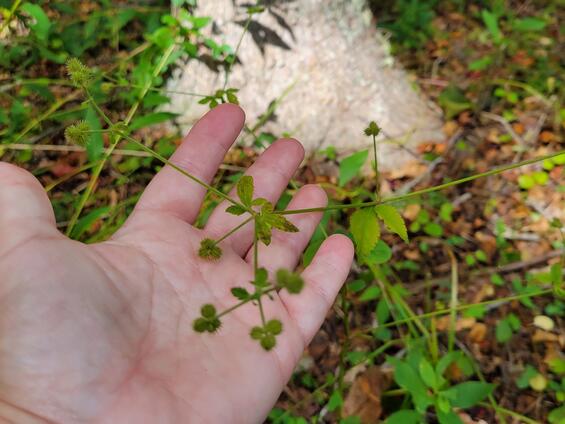
Photograph by Kelly Omand, Nantucket Conservation Foundation
Canadian sanicle, Sanicula canadensis, is a fibrous-rooted, herbaceous biennial in the parsley family (Apiaceae). It is one of four species in the genus Sanicula in Massachusetts. All are monoecious; they have separate male and female flowers on the same plant. The plants grow up to 7.5 dm (29 in) in height. Longer branches fork two to three times. The doubly serrate, palmately compound (with leaflets radiating out from a central point) leaves are three-parted, but may appear five-parted due to deep lobing on the two lateral leaflets. The male flowers are inconspicuous greenish or whitish flowers arranged in umbels (rather flat-topped groups of flowers in which all the flowers arise from a single point) with rays of differing lengths. The small, approximately globe-shaped fruits from the female flowers are borne in groups of three on 1-1.5 mm (0.03-0.05 in) long pedicels. The styles (usually slender, stalk-like portions of the pistils) are shorter than the hooked bristles that cover the fruit, suggesting the plant's alternative common name of Short-styled Snakeroot. The plant's anthers (uppermost portions of the stamens) are white. Canadian sanicle fruits from June through September.
Similar species include the other snakeroots that occur in our area: black snakeroot (Sanicula marilandica), clustered snakeroot (S. odorata), and trefoil sanicle (S. trifoliata). Clustered snakeroot differs in its bright yellow anthers, yellowish-green flowers, and the fact that its style exceeds its fruit bristles in length. Black snakeroot also has styles that are longer than the fruit bristles. The pistillate, or female, flowers of trefoil sanicle differ from those of Canadian snakeroot in having no stalks. In addition, the sepals of trefoil sanicle form a conspicuous beak at the top of the fruit. See the chart comparing the different species below.
| Sanicle Species | Calyx | Bristles | Styles | Umbellets |
|---|---|---|---|---|
| Clustered sanicle, S. odorata | Triangular, blunt, shorter than bristles | Not conspicuously expanded at base | Recurved, much protruding beyond calyx | Staminate and polygamous |
| Trefoil sanicle, S. trifoliata | Lanceolate, sharply tipped exceeding bristles | Expanded at base | Not protruding beyond calyx | Only polygamous |
| Canadian sanicle, S. canadensis | Lanceolate, sharply tipped, concealed by bristles | Expanded at base | Not protruding beyond calyx | Only polygamous |
| Black snakeroot, S. marilandica | Long, pointed; inconspicuous among bristles | Expanded at base | Recurved, much protruding beyond calyx | Staminate and polygamous |
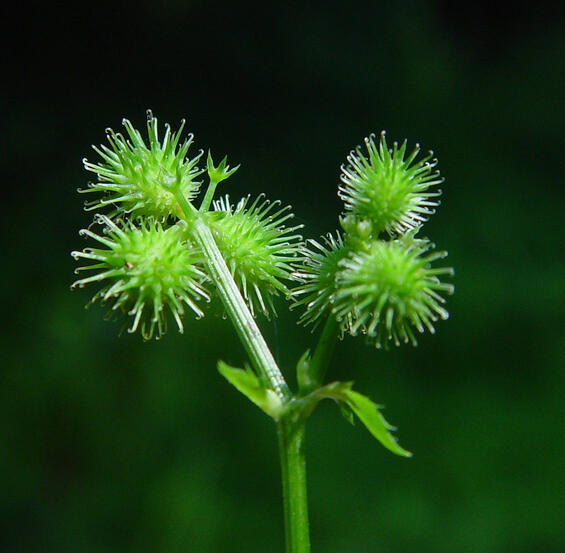
Mature flowers, note that the style is not visible beyond the hooks on the fruit, and that the sepals on the staminate flowers are sharply pointed. Photograph by Arthur Haines, Native Plant Trust.
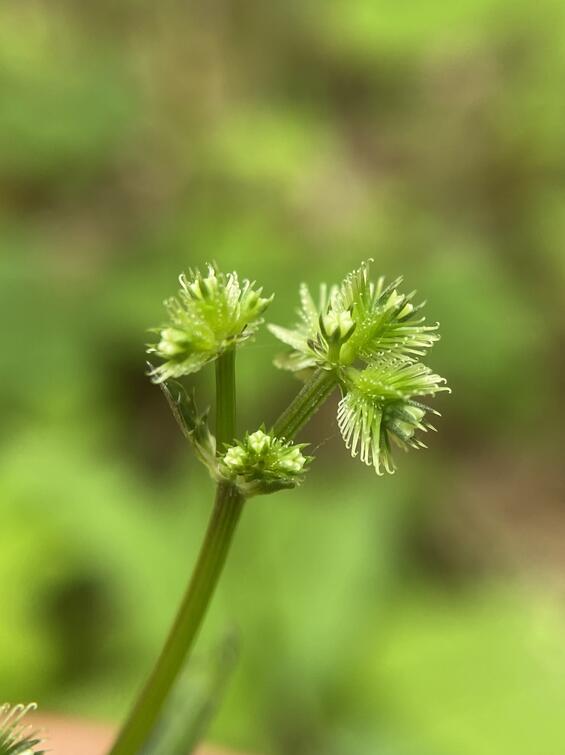
Early flowers, note that the style is not visible beyond the hooks on the fruit. Photograph by Peter Grima.
Life cycle and behavior
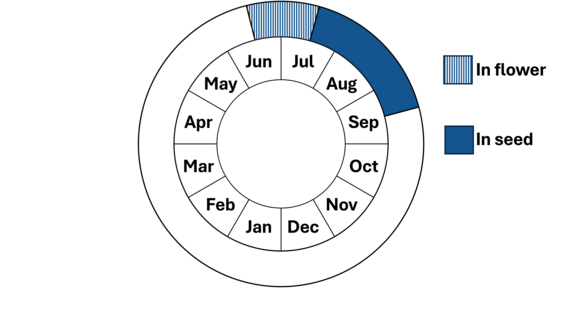
Like its more common relative trefoil sanicle, Canadian sanicle is biennial or a “facultative perennial” (Hawkins et al. 2007). A facultative perennial grows larger each year until it finally sends up a flowering shoot which can two or more years. Trefoil sanicle may be found in flower from late May to early July. Once it flowers and sets seed, the plant will die. Seeds ripen from July through September. However, the mature mericarps will remain on the dead parent plant until they have attached to the fur of an animal or feather of a bird. It may be one or more years before they are removed from the dead stem of the parent plant. Pollination is thought to be by small flying insects as it is in other sanicles (Johnson 2023). Hawkins et al. (2007) report their findings from seed germination studies indicating that some seeds may not germinate until the 6th year, which indicates that Canadian sanicle might create a persistent seed bank in the soil, and sprout when the conditions are appropriate. Several other species of sanicle have been found to associate with arbuscular mycorrhizae, it is likely that Canadian sanicle has a similar association (Johnson 2023).
Population status
Canadian sanicle is listed under the Massachusetts Endangered Species Act as Threatened. All listed species are protected from killing, collecting, possessing, or sale and from activities that would destroy habitat and thus directly or indirectly cause mortality or disrupt critical behaviors. There are 18 occurrences that have been verified since 1999 in It is currently known from Berkshire, Bristol, Dukes, Nantucket, and Plymouth Counties. It is historically known from Franklin County, as well as Bristol, Plymouth, Nantucket, and Dukes Counties. Only one population is ranked as doing well.

Distribution in Massachusetts
1999-2024
Based on records in the Natural Heritage Database
Distribution and abundance
The range of Canadian sanicle is from southern Quebec and Ontario, south to Florida and Texas, covering most of eastern North America. It is considered secure or has not been ranked in most states. In New England, Canadian sanicle is considered imperiled in Vermont and Massachusetts. It has no ranking in Connecticut, Maine, New Hampshire or Rhode Island.
Habitat
Canadian sanicle is a plant of moist, open woods and openings in them such as trail edges and tree falls. Sites in Massachusetts are nutrient rich, somewhat wet areas; sites include low knolls and mesic slopes in and along paths through extensive red maple swamps, a seepy area wet in winter-spring and mesic in summer to fall, and rich northern hardwood forests. The forests it grows in have canopies of northern and central hardwoods, often mixed, and usually mixed with successional species. The trees at the Canadian sanicle sites include most hardwoods in the state, reflecting the wide distribution of the species and a predilection for second-growth forests in fairly moist, rich conditions: sugar and red maple (Acer saccharum and A. rubrum), oaks (Quercus spp.), white ash (Fraxinus americana), tulip tree (Liriodendron tulipifera), sassafras (Sassafras albidum), various hickories (Carya spp.), beech (Fagus grandifolia), white pine (Pinus strobus) and yellow and paper birches (Betula alleghaniensis and B. papyrifera). A subcanopy of hop-hornbeam (Ostrya virginiana), hornbeam (Carpinus caroliniana) and/or witch hazel (Hamamelis virginiana) is common. The shrub layer tends to be sparse although it may have dense patches of spicebush (Lindera benzoin), highbush blueberry (Vaccinium corymbosum), northern arrow-wood (Viburnum dentatum var. lucidum), winterberry (Ilex spp.), or elderberries (Sambucus canadensis and S. racemosa ssp.).
The herbaceous layer is rich and varied; many of the species are known to grow in nutrient-rich moist conditions in northern hardwoods forests and others are more widespread. Included at many sites are wild geranium (Geranium maculatum), cucumber root (Medeola virginiana), white avens (Geum canadense), hog peanut (Amphicarpaea bracteata), Jack-in-the-pulpit (Arisaema triphyllum), wild sarsaparilla (Aralia nudicaulis), wild ginger (Asarum canadense), Virginia waterleaf (Hydrophyllum virginianum), Christmas fern (Polystichum acrostichoides), elliptic shinleaf (Pyrola elliptica), poison ivy (Toxicodendron radicans), Virginia creeper (Parthenocissus quinquefolia), dewberries (Rubus spp.), and many members of the aster family (Asteraceae).
Healthy habitats are vital for supporting native wildlife and plants. Explore habitats and learn about conservation and restoration in Massachusetts.
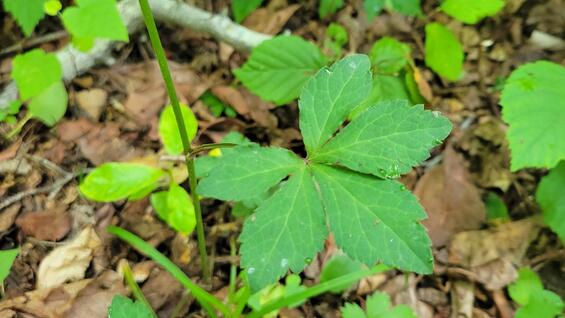
Lower stem leaf. Photograph by Kelly Omand, Nantucket Conservation Foundation.
Threats
Several of the populations occur with non-native invasive associates including common buckthorn (Rhamnus cathartica), multiflora rose (Rosa multiflora), Asian bittersweet (Celastrus orbiculata), Japanese barberry (Berberis thunbergii) and shrub honeysuckles (Lonicera spp.) All of these non-native invasive species can outcompete Canadian sanicle. Other threats may include habitat loss through construction or logging activities.
Conservation
Survey and monitoring
As with all rare plant species, regular surveys and monitoring are important to maintain the health of the populations. Canadian sanicle tends to be more widespread than most of the other sanicles so search for it over a wider area. Each plant is a separate genet. The best time to survey Canadian sanicle is in July and August when the fruits are present and the observer will be able to confidently identify the species of sanicle.
Management
Sites should be monitored for invasions of exotic plants. All active management of rare plant populations (including invasive species removal) is subject to review under the Massachusetts Endangered Species Act and should be planned in close consultation with the MassWildlife’s Natural Heritage & Endangered Species Program.
Research needs
Canada sanicle is widespread in Massachusetts. It is not well understood as it occur in a variety of habitats from the Berkshires to Martha’s Vineyard and Nantucket. Research is needed to know more about the soils and pollinators. It would be good to know if Canada sanicle can form seed banks that will allow plants to sprout when conditions are appropriate.
References
Bplant.org “Compare Plants: Canadian Blacksnakeroot vs Largefruit Blacksnakeroot, https://bplant.org/compare/1273-1276 Accessed 4/9/2025.
Gleason, Henry A., and Arthur Cronquist. Manual of Vascular Plants of Northeastern United States and Adjacent Canada, Second Edition. Bronx, NY: The New York Botanical Garden, 1991.
Haines, A. 2011. Flora Novae Angliae – a Manual for the Identification of Native and Naturalized Higher Vascular Plants of New England. New England Wildflower Society, Yale Univ. Press, New Haven, CT.
Hawkins, T. S., J. M. Baskin, and C. C. Baskin. 2007. Seed morphology, germination phenology, and capacity to form a seed bank in six herbaceous layer Apiaceae species of the eastern deciduous forest. Castanea 72(1):8-14.
NatureServe. 2025. NatureServe Network Biodiversity Location Data accessed through NatureServe Explorer [web application]. NatureServe, Arlington, Virginia. Available https://explorer.natureserve.org/. Accessed: 4/9/2025.
POWO (2025). Plants of the World Online. Facilitated by the Royal Botanic Gardens, Kew. Published on the Internet; https://powo.science.kew.org/ Accessed: 4/8/2025.
Seymour, Frank C. 1969. The Flora of New England, First edition. Charles E. Tuttle Company, Inc. Tokyo, Japan.
Contact
| Date published: | May 9, 2025 |
|---|